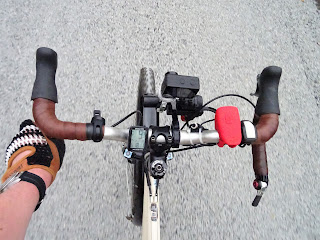April is renowned for showery, changeable weather and the past couple of weeks have been no exception. I’m sticking with wet lubes, since they’ll stay put in these contexts. That said, it’s crucial to give the side plates, derailleur jockey wheels, and cages a weekly wipe, ideally with a rag dipped in solvent.
The Zefal Extra Wet Nano Ceramic ZEFAL EXTRA WET NANO CERAMIC CHAIN LUBE | cycling-not-racing (sevendaycyclist.com) and Motovede PTFE Chain Lube Motoverde PTFE Chain Lube | cycling-not-racing (sevendaycyclist.com) are particularly stoical, although the latter requires 12 hours to cure properly.
Shimano has recently announced a switch to cartridge bearings. This gave me cause to contemplate Ursula’s XT, which is still using the original balls. Now, bearing types are, unfortunately, not cross-compatible. I.e., a hub designed for balls cannot use cartridges and vice versa.
If they were, I’d be going the cartridge route. I’ve bought the best quality (grade 10) balls and will introduce these to coincide with a grease test. Basic bearings can be as low as 100 grade, which denotes something generic- functional but less accurately machined and more prone to wear, pitting and other corrosion.
Synthetic greases are my preference, especially when it comes to contact points and threaded components. Bottom brackets, derailleurs, freewheels, bottle cage, mudguard, and carrier mounts. Hubs and headsets with seals, too. Same goes for anything with metals of different parentage.
Fluted aluminium alloy seat posts and Quill stems/adaptors in steel frames were notorious for galvanic seizure. Sure, ahead stems have long been the dominant system. However, there are plenty of people wanting to retain a beloved classic's originality and the odd new retro build with a threaded setup.
Similarly, the humble quill to Ahead converter enables older bikes to run contemporary bars and stems- without forgoing the original fork. MTB to gravel or touring lorry conversions being obvious candidates.
Mudguards, no matter how solid eventually warp and fail, 4 years and close to 40,000 miles later, the Blumels Shiny are beginning to show some obvious signs of wear. The rubberised components that dampen vibration have perished and earlier this week, my sensibilities were offended by a low-level rattling.
I pulled over and found a rivet securing guard and stays had failed. I was only a few miles from home, so rode back and decided the best route would be to clean and dry the affected area, then bond them together with superglue, clamping them in situ to cure. Glues may set within 10 minutes, at least in ideal conditions but I like to leave things overnight, longer if possible.
Ultimately, the repair didn’t take. Replacing the rivet was another option but I decided this would be unnecessarily invasive, so went for a beefy zip tie instead. This also failed, revealing further deterioration, so after some deliberation, I decided to retire both and contemplate the way forward. I will obviously fit good quality guards (fenders) of some genre, they may not be traditional chrome plastics...
I also discovered the Sigma BC 9.16 ATS Computer SIGMA BC9.16 ATS WIRELESS CYCLE COMPUTER | cycling-not-racing (sevendaycyclist.com) sensor battery had died, sop time to replace that. I should point out this is not the original, rather a third-party unit, so three months, or so’s daily service for a “pound shop” special isn’t bad going. Then of course, the fixed’s VDO head unit came out in sympathy, so I replaced that, too.
By far the most solid full-length mudguards I have ever used are Tortec Reflector. These lasted ten years before fatigue finally claimed the chrome plastics at key areas. Four seasons-snow, ice, bitter cold, hell and frequently high water. Tortec made some equally solid racks, too.
All this presented the ideal opportunity to get some miles in on the fixed gear winter/trainer, which saw less winter action, courtesy of the persistently icy conditions. Contexts demanding spikes, hence my defaulting to Ursula. Talking of upgrades, I’ve concluded that while the existing KMC are very cheerful, I’m better served by a higher-end model, such as the Z1X (which has returned 3,000 miles in very harsh conditions).
By the same token, I still have a couple of S1 in stock, and they perform well enough, so I’ll use those before considering said upgrade. Icy crosswinds and bracing headwinds reminded me why I don’t go steeper than 76inches- quick enough for cruising on the flat, doesn’t see me spinning into the next dimension on the descents and I’m not busting my knees on the climbs.
Talking of favourites, I’ve gone back to the Shimano RX600 Shimano SH RX600 Gravel Cycling Shoes | cycling-not-racing (sevendaycyclist.com) shoes and their vastly superior power transfer. Much closer to a traditional road shoe, just with a little more compliance and a very grippy sole. It shouldn’t be inferred that Shimano MT701 GTX SPD Shoes Shimano MT701 GTX SPD Shoes | cycling-not-racing (sevendaycyclist.com) are also rans-far from. I remain a big fan.
Rather, it's horses-for-courses- they’re a better bet for bike packing and more traditional touring/commuting. Contexts where you might want a sole with some extra give. FLR Rexston Active Touring/trail Shoe are another solid choice, if you’re on a tighter budget FLR REXSTON ACTIVE TOURING/TRAIL SHOE | cycling-not-racing (sevendaycyclist.com)










